The automotive industry has undergone a remarkable transformation in recent years. From autonomous vehicles to connected cars, the innovations seem limitless. At the heart of this automotive revolution are embedded systems, and at the core of embedded systems is firmware development. In this blog post, we delve into the intricate world of firmware development for automotive embedded systems.
The Significance of Firmware in Automotive Embedded Systems
Imagine your car as a sophisticated computer on wheels. It’s not just about driving from point A to point B anymore. Modern vehicles are equipped with a plethora of electronic components, sensors, and control units that work seamlessly to provide comfort, safety, and performance. This synergy is orchestrated by firmware.
Firmware is a type of software that is permanently stored in a hardware device, often referred to as embedded systems. In the automotive context, firmware is responsible for controlling various aspects of the vehicle, including:
Engine Management: Firmware optimizes fuel injection, ignition timing, and other critical parameters for engine performance and fuel efficiency.
Safety Systems: From airbag deployment to anti-lock braking systems (ABS), firmware ensures that safety mechanisms respond swiftly in critical situations.
Infotainment: Your car’s entertainment and navigation systems rely on firmware for seamless functionality.
Advanced Driver Assistance Systems (ADAS): Firmware is the backbone of features like adaptive cruise control, lane-keeping assistance, and parking assistance.
Connectivity: With the advent of the Internet of Things (IoT), firmware connects your vehicle to the cloud, enabling over-the-air updates and remote diagnostics.
The Challenges of Firmware Development in the Automotive Industry
While firmware development is crucial for modern vehicles, it comes with its fair share of challenges:
- Safety and Reliability
In the automotive industry, safety is paramount. Firmware must be rigorously tested and meet stringent standards to ensure that it doesn’t compromise the safety of the vehicle’s occupants and others on the road. Any glitches or malfunctions can have dire consequences. - Complexity
Modern cars are equipped with a multitude of electronic control units (ECUs) that communicate with each other. Coordinating these ECUs and ensuring they work in harmony requires intricate firmware development. - Regulatory Compliance
The automotive industry is heavily regulated to ensure safety and environmental standards. Firmware developers must stay up-to-date with these regulations and incorporate them into their designs. - Cybersecurity
As vehicles become more connected, they also become vulnerable to cyberattacks. Firmware developers must implement robust cybersecurity measures to protect against unauthorized access and data breaches.
The Future of Firmware Development in Automotive Embedded Systems
The future of firmware development in the automotive industry is poised for even greater innovation and challenges:
- Autonomous Vehicles
The development of autonomous vehicles relies heavily on advanced firmware. These vehicles must process vast amounts of data from sensors and make split-second decisions, demanding highly sophisticated firmware algorithms. - Electric Vehicles (EVs)
With the rise of EVs, firmware will play a crucial role in managing battery performance, charging, and energy efficiency. - Connected Cars
As cars become more connected, firmware will continue to evolve to support features like remote diagnostics, predictive maintenance, and over-the-air software updates. - Environmental Concerns
Firmware developers will need to focus on optimizing engine performance and emissions control to meet stringent environmental regulations.
Conclusion
Firmware development for automotive embedded systems is at the forefront of automotive innovation. It’s the invisible hand that guides the modern vehicle, ensuring it performs efficiently, safely, and reliably. As the automotive industry continues to evolve, firmware developers will face new challenges and opportunities, making this field an exciting and crucial part of our transportation future.





